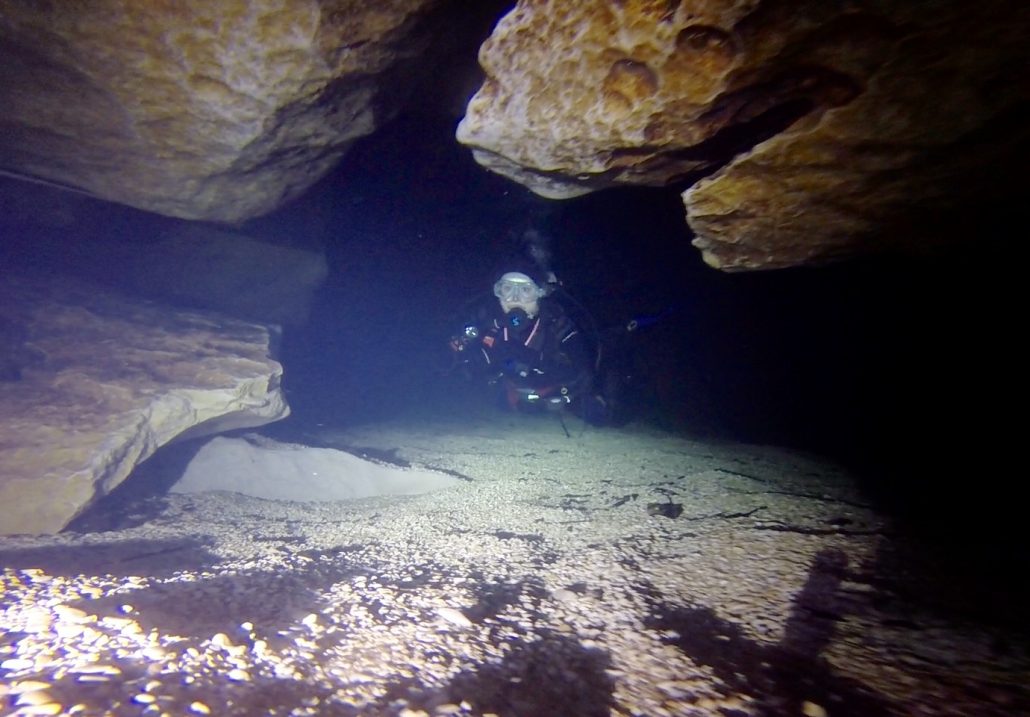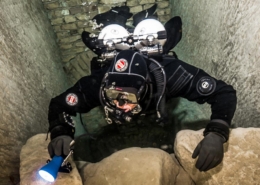The Difference Between Caves and Mines
“It isn’t all that big, and it does not go far back.
“That, of course, is the dangerous part about caves, you don’t know how far they go back, sometimes, or where a passage behind may lead to, or what is waiting for you inside.” — JJR Tolkien
When I started my first forays into underwater caves and submerged cave passages in 1992, things were a little different from how they are now. I had grown up around caves. My father was a dry cave explorer and a member of an active Speleological club The Wessex Cave Club in Somerset, UK. I’m still active within that club.
I started diving at the age of 14. At 18 I met a British cave diver at The Wessex by the name of Malcolm Foyle. He knew I was an open-water diver and a caver and said words that changed my history! “You want to come with us lad.” I started training to become a cave diver.
Back then we only really dived caves, not mines. Our aims were to further the exploration of naturally formed caves. This included completely flooded cave systems and dry caves that ended in sumps. Sumps are the parts of a dry cave that are submerged.
To pass the sump and discover more dry passage was the aim of the game. Sometimes a deadly serious game. We only ever ventured into mines for training. This happened when the weather was bad and rainfall caused natural caves to flood.
In the early 1990s, you would not see other divers in mines. The original dive lines put into the few mines we dived were done so by bored cave divers in bad weather or those undergoing training. Mine diving had yet to become a sport in its own right.
Things change
By the mid-1990s, technical diving was starting to grow. To do so, it had to fight for recognition from traditional diver training organizations. These entities often declared us all insane…or worse.
Tech divers started joining traditional cave divers in exploring mines. It was a challenging environment with the potential for some deep, long dives. Generally, it is a little easier to access mine diving sites than naturally occurring caves. This is true in both the UK and around the world.
Fast forward to today’s technical divers and mine diving has become an active subsection of our diving community. Some divers just want to dive mines. and nothing else some divers only seek mine diving training and not Cave Diver training.
You can find flooded mines, that you can visit and dive all over the world. Everyone has their favorites. What I’m starting to see and hear on social media is divers calling mines caves. They state that they are “Going cave diving,” or, “I just dived this fantastic cave.”
This in itself is not really a big problem. It’s just the wording…or is it?
- Do you understand the difference between a mine and a cave?
- Do you know why, if you are trained for one environment, you need to get training to start diving in the other?
Let me explain.
It’s all in the name
When you did your Full Cave Diver or Mine Diver training, your instructor should have explained several things. These included the procedures for contacting rescue and Emergency Services for the various areas around the world you are planning to cave or mine dive. At the very least, your instructor told you how to get that information. It’s your back up, your failsafe if the worst was to happen. If you are late out from your underground journey, is someone coming to look for you?
In the UK, we have The Cave Rescue Organization or CRO. To contact the CRO, you dial 999 and ask for police and cave rescue. You then give the controller the name of the underground site.
Saying you are in Aber-Las Cave when in fact you are actually in Aber-Las Mine causes confusion. It can cause delays whilst the teams try to work out where you actually are. Those delays may be critical to you.
A mine is like a shipwreck
A Cave has formed naturally over eons. They are carved slowly out of solid rock, generally limestone or dolomite. They have all manner of curves, rock shapes and formations. These are caused by the running of underground rivers and, if the cave was dry, the dripping of surface water. (when the cave was dry) No one section of the cave will be the same as the last.
A mine is a disused place of industry that has flooded. It may be only a few hundreds of years old, or in some cases a few tens of years. You find mines will be found in many different rock types depending on the material or ore that the mining company was extracting. These may include slate, limestone, iron ore, silica, lead, chalk, tin even uranium.
Mines are man-made structures. They are not really supposed to be there. They are not designed by nature, very much like a shipwreck and equally exciting to dive.
Now the problem with this is, it was a place of work. It was probably excavated over 100 years ago, when health and safety was not so much of an issue. Back then, the safety structures were put in place are not of today’s standards. They are also very old.
That pit prop the miner put in place? Well, he knew a lot more about mining and mines than we do and he thought the roof needed supporting. I suggest the roof still needs support, so don’t go poking that pit prop or tying your dive line to it!
Flooded sections of mines are supported in part by water. Remember your exhaled gas on open circuit causes localized gravity when the bubbles create air bells deep within the mine passage. These deep water air bells take away the supporting nature of the water as well. They may also contain low 02, high C02 and any other gasses. Please don’t take your regulator out in an air bell. Better still, just don’t go in them. This has been a fatal mistake for some divers.
Much like shipwrecks, mines may contain some very cool artefacts. These can range from trucks to railways, and from tools to mine graffiti. Mines can also pose some of the same dangers as wrecks. These include sharp metal edges, jagged pipes, and unstable walls. You won’t find these dangers in caves, with the exception of those with loose rocks and boulders. This is not common, thoughin most caves divers visit.
Line laying and line management
The way you use guidelines in caves and mines is largely the same. You maintain a continuous guideline to the exit at all times. Depending on what part of the world you are in will depend on what line system you will find.
For example, the guideline system you find in the UK differs substantially from that in use in north Florida.
- There are no gold lines.
- Lines generally start at the surface, eliminating the need for primary reels.
- Most intersections are “tee’d,” so no jump or gap reels.
- UK guidelines are generally thicker; standard line arrows may not fit.
Tie off points may differ between caves and mines. In mines, you may be able to use the mine structure itself as a tie-off point. However, you must use caution. Remember the pit props you don’t want to touch? There is also the possibility of a line being cut on sharp metal objects.
The conservation of mine artefacts don’t tie into a 100-year-old train truck. Move your divers around it.
In the cave environment, it’s highly possible to find naturally occurring line traps especially when the cave changes direction, in most mines the passage is uniform in size and more square shaped, remember this was a place of work. Line traps can still be found in mines but generally occur around man-made, structures not in the walls common to caves.
Silt is also a problem in mines but the mine has no flowing water like a cave and the disturbed silt will take longer to drop back out of the water and clear up. Mine divers need to practice and train for all of this as much as any cave diver if not more! Again, do your research or take a guide if planning a trip away from your local sites.
Navigating mines
When in the cave environment and if you have studied the caves, they will tell you much about navigating within that environment. Obviously, the guideline remains your primary navigation tool, along with line arrows and non-directional markers. However, caves are a natural watercourse. If you look and read things such as:
- Scallop markings in the rock
- Sand ripples on the floor
- The way sticks and leaves wash into a cave
They may tell you:
- The direction of flow
- Which way water enters and exits
- Whether you are in a primary passage or offshoot passage
With time and experience, all these things can help you navigate…as long as you pay attention.
Mines, on the other hand, are very different.
- These man-made tunnels have no flow.
- There are no markings on the walls.
- Passages are generally uniform in shape.
- They follow the direction of the ore or other material being removed.
Understanding how miners removed the material they wanted and stacked what they did not want (the “deads”) is critical to mine navigation. For example, the Slate Mines of North Wales are on a roughly 45-degrees angle from the surface. They are also a three dimensional passage. This means you can be in the same passage but on three different levels.
Do you know what a drainage level looks like compared to a working level? You won’t find your way back to the exit if still in the drainage level. Losing the guideline in large mine passages would be an extremely bad thing to do. This is why learning natural and mine navigation techniques is critical.
Access, Conservation and Enjoyment
All caves have access agreements in place that cave divers to access the site:
- Over someone’s land
- Via a public park
- Through community land or private land
If not, access is restricted or closed.
Mines have similar access requirements. They will also have an owner like a shipwreck. The mineral rights will be owned by someone who may not want you exploring their mine. Or, they may grant access but state it is at your own risk.
You need to care for the mine environment as you would a naturally occurring cave. If you took it in, take it out. Do your research or take a guide. Find out as much as possible about the site. The more you know, the more you will enjoy and preserve the environment for future divers. See you underground soon.














 Natalie L. Gibb
Natalie L. Gibb
השאירו תגובה
רוצה להצטרף לדיון?תרגישו חופשי לתרום!